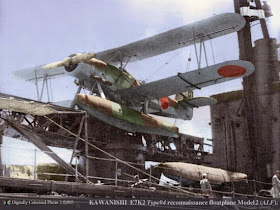Tuesday, March 3, 2015
Kawanishi E7K
In March 1932 Aichi and Kawanishi began the competitive design of a new three-seat long-range reconnaissance f1oatplane. This was required by the Imperial Japanese Navy air force as a replacement for the Navy Type 90-3 Reconnaissance Seaplane which, built as the Kawanishi E5K, had proved to be disappointing in service use. A fabric-covered equal-span single-bay biplane of conventional design and construction, the Kawanishi E7K1 was carried on large strut-mounted twin floats, accommodated a crew of three in tandem open cockpits, and was powered by a 620-hp (462-kW) Hiro Type 91 'arrow' engine. First flown on 6 February 1933, the prototype passed its manufacturer's tests satisfactorily and in late May 1933 was handed over to the Japanese navy for service trials in competition with the AB-6 developed by Aichi to meet the same requirement. Navy evaluation left little doubt that Kawanishi's new floatplane was the better of the two, but no production order was forthcoming until after the receipt of a second prototype in late 1933. Some six months later, during May 1934, the E7K1 was ordered into production and given the designation Navy Type 94 Reconnaissance Seaplane. When it began to enter service in early 1935, the E7K1 very soon gained a good reputation for ease of handling, both on the water and in the air, but performance of the Hiro engine, derived from a French Lorraine powerplant, was disappointing. As a result, late production aircraft had a more powerful (750hp/ 559-kW) version of the Hiro Type 91 installed, but this proved no more reliable and with E7K1 production then totalling 183 (57 built by Nippon) Kawanishi began to look at alternatives.
During 1938 the company built a prototype E7K2 which was generally similar to the earlier production aircraft, but with the unreliable Hiro engine replaced by a Mitsubishi Zuisei (holy star) 11 radial engine. Flown for the first time during August 1938, this was ordered into production by the navy some three months later under the designation Navy Type 94 Reconnaissance Seaplane Model 2; at the same time the E7K1 version was retrospectively redesignated as the Navy Type 94 Reconnaissance Seaplane Model 1. Production of the E7K2 totalled about 350 aircraft, some 60 built by Nippon, and the E7K as a type saw extensive use for both beach- and ship-based operations from 1935 until the beginning of the Pacific war. By that time the E7K1s had been relegated to second-line duties, but the radial-engined higher-performance (some 23 mph/37 km/h faster) E7K2s remained in first-line roles until early 1943. These included antisubmarine patrol and inshore convoy escort, tasks for which they had never been intended, and many were still in use in liaison and training roles when the war ended. One more job remained, for like many obsolete types the E7Ks were pressed into service during the late stages of the war to take part in desperate kamikaze attacks. When, in the second half of 1942, codenames began to be allocated to Japanese aircraft to provide a simple and easily pronounceable means of referring to a type, the E7K2 became known as 'AIf', male Christian names being allocated to aircraft that were deployed basically as fighters or reconnaissance seaplanes.
Variants
E7K1
Production version with a Hiro Type 91 engine, 183 built (including 57 built by Nippon Hikoki K.K.)
E7K2
Re-engined version with a Mitsubishi Zuisei 11 radial engine, about 350 built (including 60 built by Nippon Hikoki K.K.)
Specifications (E7K2)
General characteristics
Crew: 3
Length: 34 ft 5½ in (10.50 m)
Wingspan: 45 ft 11¼ in (14.00 m)
Height: 15ft 10½ in (4.85 m)
Wing area: 469.305 ft² (43.60 m²)
Empty weight: 4,630 lb (2100 kg)
Loaded weight: 7,275 lb (3300 kg)
Powerplant: 1× Mitsubishi MK2 Zuisei 11 14 cylinder radial engine, 870 hp (649 kW)
Performance
Maximum speed: 275 km/h (171 mph)
Cruise speed: 100 kt at 1000 m (115 mph at 3,280 ft)
Service ceiling: 7,060 m (23,165 ft)
Wing loading: 15.5 lb/ft² (75.7 kg/m²)
Armament
Guns: 1× fixed and 2× trainable 7.7mm (0.303in) Type 92 machine guns
Bombs: 120 kg (265 lb) of bombs




No comments:
Post a Comment